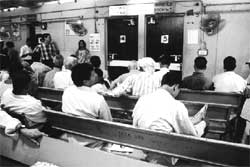System error
 The registries would have helped formulate a control programme . But in absence of the data, the nccp has been forced to source information from other places. "We use World Health Organisation's projections,' says Sudhir Gupta, chief medical officer, directorate general of health services at the mohfw. Ironically, the ncrp was supposed to generate data for the nccp. Now nccp is creating its own database to make up for ncrp's incompetence and justify its existence. It recently launched the modified district cancer control programme in four states: Bihar, Uttar Pradesh, West Bengal and Tamil Nadu. The problem is that without data, it is difficult to assess the performance of nccp.
The registries would have helped formulate a control programme . But in absence of the data, the nccp has been forced to source information from other places. "We use World Health Organisation's projections,' says Sudhir Gupta, chief medical officer, directorate general of health services at the mohfw. Ironically, the ncrp was supposed to generate data for the nccp. Now nccp is creating its own database to make up for ncrp's incompetence and justify its existence. It recently launched the modified district cancer control programme in four states: Bihar, Uttar Pradesh, West Bengal and Tamil Nadu. The problem is that without data, it is difficult to assess the performance of nccp.
What started off as a exercise to provide treatment is today thought of as just a trading house for radiotherapy machines. "Maximum focus was on these machines as most of the members of the advisory committee were radiologists,' feels Shastri. The programme has emphasised so much on the machines that doctors opine that that most members of the medical fraternity remember the nccp only when funds are needed for equipment.
"Though there are around 280 machines in around 174 hospitals in India, there is a lack of infrastructure to cater to the growing cancer patients,' accepts Gupta. The situation is pitiable that between Delhi and Lucknow, only Bareilly has a radiotherapy machine, says Agarwal. Realising its failure to treat cancer, the focus has now shifted to cancer prevention through awareness.
Too late!
As most patients in India are diagnosed only at the late stages, curing the disease becomes difficult, feel most experts And this increases the mortality rate. This is largely to do with lack of awareness. According to the Centers for Disease Control and Prevention, usa, surveillance is an effective way of identifying disease-prone areas. For example, in the case of breast cancer, a tmc study showed that if the woman is diagnosed at stage i, the survival rate is around 97.3 per cent. But if the case is diagnosed in stage iv, the survival rate is only 37.6 per cent.
In Barsi, Maharashtra, for example, increased awareness resulted in more cervical cancers being identified in early stages and resulting in increased survival rates
Related Content
- Enhancing policy and action for safe mobility
- Bayesian Network Model for flood forecasting based on atmospheric ensemble forecasts
- Performance comparison of solar photovoltaic models for plant siting in India
- Bias-correction and dynamical downscaling strategy to improve the prediction of extreme weather events on extended range
- System error, reboot required: review of online ivory trade in Japan
- Observational constraint on cloud susceptibility weakened by aerosol retrieval limitations
